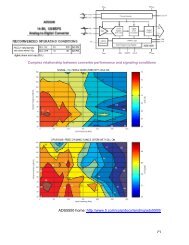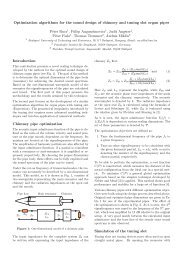HP 33120A User's Guide
HP 33120A User's Guide
HP 33120A User's Guide
Create successful ePaper yourself
Turn your PDF publications into a flip-book with our unique Google optimized e-Paper software.
Chapter 7 Tutorial<br />
Signal Imperfections<br />
The maximum output frequency, with the condition that every<br />
waveshape point in RAM is output every waveform cycle, is defined by:<br />
Fout = Fclk / Points<br />
The minimum number of points required to accurately reproduce a<br />
waveshape will determine the maximum useful output frequency using<br />
the same equation.<br />
The rule governing waveforms is referred to as the Nyquist Sampling<br />
Theorem, which states that you must include at least two points from<br />
the highest frequency component of the signal you are attempting<br />
to reproduce.<br />
Signal Imperfections<br />
Most signal imperfections are easiest to observe in the frequency<br />
domain using a spectrum analyzer. Sampling theory predicts the<br />
location and size of spurious signals resulting from the sampling<br />
processes used by DDS generators. In fact, since DDS generators use a<br />
fixed sampling rate (40 MHz for the <strong>HP</strong> <strong>33120A</strong>), spurious signals can<br />
be removed with a fixed frequency “anti-alias” filter. A 17 MHz,<br />
ninth-order elliptical filter providing a sharp cut-off (in excess of 60 dB<br />
attenuation for signals greater than 19 MHz) is used for sine wave<br />
outputs. A 10 MHz, seventh-order Bessel filter is used for non-sine wave<br />
outputs. The Bessel filter provides slower amplitude roll-off for<br />
anti-alias filtering, but maintains linear phase response to minimize<br />
shape distortion for complex waveshapes. The <strong>HP</strong> <strong>33120A</strong> automatically<br />
selects the appropriate filter when the output function is selected.<br />
All digital-to-analog converters, including those used in DDS generators,<br />
produce spurious signals resulting from non-ideal performance. These<br />
spurious signals are harmonically related to the desired output signal.<br />
At lower frequencies, the <strong>HP</strong> <strong>33120A</strong>’s 12-bit waveform DAC produces<br />
spurious signals near the -74 dBc level (decibels below the carrier or<br />
output signal) as described by the equation on the following page.<br />
The <strong>HP</strong> <strong>33120A</strong> uses the complete vertical resolution (N=1) of the DAC<br />
for all internal waveshapes, thus minimizing amplitude quantization error.<br />
276
















